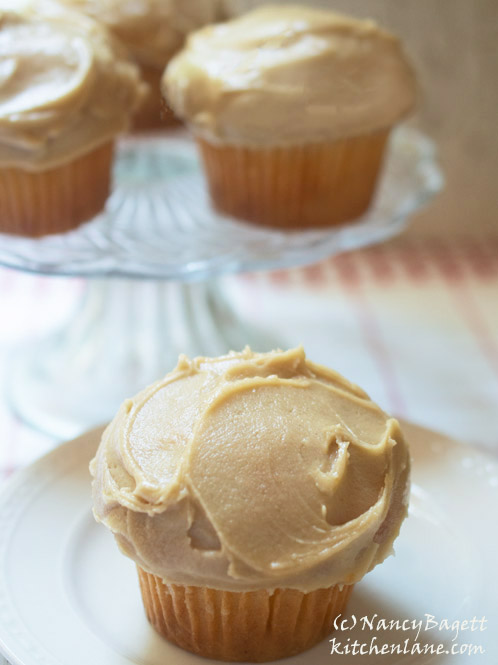
Creamy-Smooth American Caramel Frosting
Yesterday, I posted a short Instagram video https://tinyurl.com/zh8w5f5z showing myself icing my grandson’s birthday cake with this frosting. Suddenly a lot of peeps were drooling and clamoring for the recipe! So here it is.
Called “American Caramel Frosting,” it’s from my All-American Dessert Book. As you can see from both the video and this still photo, the frosting is exceptionally smooth and creamy. Even more important, it stays that way. Many versions of this frosting tend to dry out and become sugary, but this updated one remains succulent even after several days of storage. In fact, in hot, humid weather it can become a little soft (due to the butter), so needs to be kept covered and in a cool place.
My recipe is adapted from my mother’s, which tasted wonderful, but frankly, it often did turn grainy and dry on the second day. After lots of testing, I solved the graininess problem by incorporating a little corn syrup. This ingredient happens to very effective at preventing sugar from crystalizing and turning gritty, so don’t leave it out. To prevent dryness, I incorporated enough extra cream and butter to produce a runny frosting, then let it stand long enough for the powdered sugar to absorb plenty of liquid before gradually stiffening the mixture to a spreadable consistency. In pastry chef lingo, I let the powdered sugar fully hydrate in the bowl. This meant it wouldn’t draw up more moisture and dry out the frosting once it was on the cake.
In case you wonder, American caramel frosting and French caramel frosting are not alike. They’re similar mostly only in name and in that they feature sugar! Traditional “American Caramel Frosting” gets its flavor from brown sugar, not cooked caramelized granulated sugar, as classic French caramel does. Since the sugar isn’t coooked until dark and bitter (caramelized), American caramel recipes tend to be sweeter, lighter in color and more mellow tasting than French caramel. American caramel frostings have been popular for well over a hundred years. The first recipe I’ve come upon is in the 1896 edition of the Boston Cooking-School Cook Book by Fannie Merritt Farmer. My version here is a favorite for family birthday and holiday cakes. It was a hit on the yellow layer cake at my grandson’s party last night.
- ½ cup plus 2 tablespoons (1 stick plus 2 tablespoons) unsalted butter, cut into chunks
- 2½ cups packed light brown sugar
- ¼ cup light corn syrup
- Generous pinch of salt
- ½ cup heavy (whipping) cream, at room temperature
- 3 cups powdered sugar, plus ⅓ cup more, if necessary
- 2 teaspoons vanilla extract
- In a heavy 2-quart saucepan, using a long-handled wooden spoon, combine the butter, brown sugar, corn syrup, and salt. Stirring constantly, cook over medium heat until the mixture just comes to a boil. Immediately stir in the cream, standing back to avoid any splattering. Bring the mixture back to a boil and cook, stirring, for 1 minute. Strain the mixture through a fine sieve into a large mixer bowl. Let stand to cool 5 minutes
- Add 3 cups powdered sugar and vanilla to the bowl. With a mixer on low, then medium speed beat until completely smooth and free of lumps, 2 to 3 minutes; scrape down the bowl as needed. Let stand until cool to the touch and stiff enough for frosting, at least 30 minutes. (Or to speed cooling, set the bowl in a larger bowl of ice cubes and cold water, and let stand, stirring occasionally, until cool to the touch and stiff enough for frosting, 10 to 15 minutes.)
- If the mixture seems too stiff for frosting when completely cooled, thoroughly stir in a teaspoon or two of water. Beat the frosting on medium speed just until lightened in color, slightly fluffy and creamy but not too soft to spread, about 1 minute; don’t overbeat or it will overheat and soften too much to frost easily. If the mixture still seems too soft for frosting when completely cooled, sift ⅓ cup more powdered sugar into the bowl and beat just until incorporated, about 1 minute. Then spread the frosting on a thoroughly cooled cake, or cupcakes. Makes enough to frost a large layer cake.

So glad you like it. “Spread” the word. N
Absolutely AMAZING! This is so smooth and spreadable, it’s insane. No gritty or grainy texture! My new go-to caramel icing recipe. Thank you!